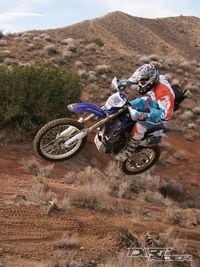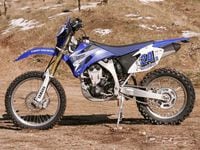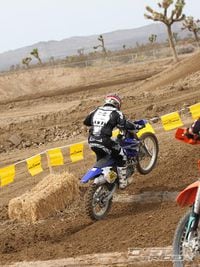The 2009 Yamaha WR450 could become your next favorite off-road ride. With a little diet work and some Factory Connection suspension service, ours has found its groove.
I'm guessing our 2009 Yamaha WR450 has about 30 hours on it. And I'm having a hard time remembering when I've had a better time on a stock(ish) WR.No, you didn't miss a press release announcing an all-new Yamaha WR450. It's not a new bike. It's actually an old bike-one that has little or no updates in the past three years. But, as is often the case, as we approach the end of a model's lifespan before a major overhaul, we really know what to do to the bike to make it work in the real world. And our WR is really working.First, let's recap what the stock WR is. It's really solid, basically. With ample power in a quiet and comfortable package, Yamaha's big off-road bike can handle the tightest, sharpest trails with ease and confidence. Motorability (that's a made up word for easy-to-use power delivery with a torque heavy punch) is the key and propels this pony from steering stop to steering stop around the trees, up the hills and over the woods. The clutch is a pleasure to pull and the bike resists boiling over quite well but has a reservoir bottle in case you tend to abuse.WR 450 motors are fast, too. How fast? Uh, it's hard to tell because they're almost silent. But what happens is this: you twist the throttle and Motorability happens (I made that up, too). Then, the front tire lifts off the ground and you're in a wheelie even though you don't hear anything. I suggest turning your wrist clockwise to avoid blowing by the fast approaching corner. It's a motor that torques down low, rips in the mid and goes on, and on, and on, and on. It's cool.If you need a reminder of the durability of Yamaha WR motors pleaser refer back to our 2007 Yamaha WR 250 Long Haul test bike which laughed off over 200 hours of not-nice riding by the jerks (myself included) at Dirt Rider.The chassis is just on the rigid side with a tall-standing feeling from the pegs to the gas cap and it reacts quickly to your body's movements. Ergonomics are spread out nicely for big-and-tall guys as well as the average male rider in the 5'10" range. WR's are also well know for having the magic ability to fit shorter-legged pilots and most female riders due to their low-ish seat height.Even though it seems at home in tight and technical trail situations, the WR really enjoys the fast lane. It has a stable nature to it that is almost unmatched in high-speed roads and the transmission has the gears to pull you and your business down whatever fast section you desire. And the transmission works better out in the open as well. In the tracks and trails of the world, the spacing from 2-to-3 and 3-to-4 can be just wide enough to have a rev-bog relationship that's annoying.Interestingly, when the speeds pick up, the stock WR runs into a bit of a performance ceiling based solely on its suspension. As a compromise to handle abrupt hits, Yamaha has the stock fork and shock combo valved and sprung on the soft end of the spectrum. This is nice in the slow-go but when you hit the third sand whoop, anywhere between 45 and 900 mph, the wallow monster shows up in full force. All of a sudden, the bike gets heavy, slow steering and hard to predict. Sometimes it ends up on one side of the trail and you end up in a cactus. It will give you plenty of warning, though. So back her down a notch on the bumps.With this general consensus on the WR lineup we went to work on the bike for this year's shootout. To get the Japanese bikes on par with the best offerings from Europe, we decided to add a few modifications. After all, KTM's and Husabergs are delivered as "Race Ready" and Honda, Kawasaki and Yamaha build trail bikes. We need to compare apples to apples so we made apples that you'd likely build or buy. The overall character of the WR is greatly enhanced by these changes and if you currently own a WR and are considering an upgrade, check out what a little aftermarket love can do for your ride.First on the Yamaha was the Factory Connection suspension service. Factory Connection (www.factoryconnection.com) serves up a sweet mix of WR goodness with their mods. And, since they deliver components and setup for the AmPro Yamaha GNCC team, they should be good at it. Our goal was to get the WR more into the mildly aggressive realm and away from the sit-down-and-trail-ride side. We wanted a lighter-feeling bike with better bottoming resistance and much more progression in the bottom half or third of the stroke. We didn't want to sacrifice slow and sharp bump compliance either. That's exactly what Factory Connection delivered.It's almost unbelievable the difference the suspension modifications made on this model. It takes the bike from soft and squishy to standing tall and being reactive. It will have your confidence skyrocketing. In fact, I recently raced this bike in a WORCS race that was full of sand whoops the size storage sheds and it was only a bit too heavy and soft in the last 20 minutes of the hour-long race. My body was making the task pretty hard for the bike as well as it exhaustively leaned on the Yamaha. On a stock WR, I would have likely been making sand angels at the half-hour mark. My only complaints on the day of high-speed, big bump racing was the aforementioned transmission gaps and adjusting to going this fast so quietly which was a true joy when I realized I was invisible to the guys I was passing. Boo!We have also learned how to make the WR into a real bike. This means we replace the throttle stop so it now opens all the way and the gray wire to the ignition box is disconnected, only the smallest insert in the stock exhaust is removed and the air box snorkel is taken out. All of this makes the WR the bike I rode at the Racetown 395 WORCS (www.racetown395.com) race.The only other performance modification we did to the WR was to ditch the heavy stock battery with a lightweight Ebatt (www.ebattonline.com). It's easily two pounds lighter and has been working well despite our attempts to wire it incorrectly and fry it to death. The weight loss is felt ten fold since the battery is located so high in the chassis. It makes a difference, for sure. We also bolted on a set of Enduro Engineering hand guards (www.enduroeng.com) because we like our fingers.We're sure there will be an all-new WR model in Yamaha's lineup in the next year or two with fancy bells and whistles and sweet stickers. And we're excited to see what that brings. But thanks to Yamaha for building such a versatile machine, we're not overly eager to give up our 2007-2009 versions.MSRP: $7499
Claimed Weight (tank full): 271 lbs.
Actual Weight (Tank Full/empty): 273 lbs.
Seat Height: 38.6"
Footpeg Height: 15.7"
Ground Clearance: 12.6"
Street Legal (y/n): No
Fuel Capacity: 2.1 gal.
Transmission:**** 5 speed
**Manufacturer Website: www.yamaha-motor.comOpinions:Yamaha WR450
Ever since Yamaha put the aluminum frame on the WR450F it has been a favorite of mine, and that is understandable considering my attraction to the YZ it s based on. The Yamaha hides its weight well with a low center of gravity. The power is smooth, useable and energetic, and best of all quiet. It is a fairly easy bike to maintain, and it stays feeling fresh and new for a good while. It is a little bit of a rolling wedge in ruts, and it is wider and lower at the peg mounts than the KTM. The riding position works for short guys without really bothering me, having Factory Connection fine-tune the suspension simply raised the caliber of the entire package. I like it.
Karel Kramer
6'1"/225 lb. /B riderFirst off, the only big bikes that I have ever owned have been orange, that being said I am very biased and think that KTM motorcycles rule the land. However, I hopped on the WR and was blown away at how great the bike worked. It had a surprisingly light feel and I could easily move around on the bike. The first section of trail that I tested the bike on was basically a twisty rut track through the desert. The motor was very strong and that was something that I was not expecting. In the past I have always read about how you have to take off the stock exhaust and make several adjustments to the carb and airbox to make the bike run. The motor pulled great off the bottom and would even rev out pretty far but I found that it liked being in the lower part of the power band. The suspension soaked up the braking bumps and although it felt a little soft on the bigger hits I would much rather be able to charge through chop and slow down for a big g out than get my bones rattled on the small stuff. Next up was the extreme test and once again the bike worked great, the harder I pushed the bike, the better it worked! On the way to the next section of trail which was the longest and I think most challenging loop I stopped at the Yamaha truck to visit with Randy Hawkins a little and tell him that I had a new thing for the blue bikes. Randy and the rest of the am pro team laughed and I took off up the hill to see what else this bike could do. This section had a lot of sharp off camber corners as well as several narrow creek beds littered with rocks. I kept waiting for the clutch to get a little soft or the bike to overheat but nothing ever happened. The clutch action was great the entire time and I was surprised at how easy the clutch pull was. Overall the bike was great. I didn't want to get off of it and I think that I spent a good two or three hours on the bike, it was that much fun!Cole Kirkpatrick
Ride impression from our Annual Torture Test Event




/cloudfront-us-east-1.images.arcpublishing.com/octane/33UTMDHIH5B45HVOLFJ6GD76QY.jpg)
/cloudfront-us-east-1.images.arcpublishing.com/octane/44W4OD5KDZFD3FQWWHZV63P4TY.jpg)
/cloudfront-us-east-1.images.arcpublishing.com/octane/SQ3CEIVCOJF7FDERDVDKKPIC7A.jpg)
/cloudfront-us-east-1.images.arcpublishing.com/octane/LLLQLRK2DBH4PN66MDNA3AFJNY.jpg)
/cloudfront-us-east-1.images.arcpublishing.com/octane/5DMU4K752FBWLLJD432GRAAH2A.jpg)
/cloudfront-us-east-1.images.arcpublishing.com/octane/TGHDVMIODJC4BNKJDZKKTSWXWI.jpg)
/cloudfront-us-east-1.images.arcpublishing.com/octane/5KYMT24REJEFPNO2J2M76MXERM.jpg)

/cloudfront-us-east-1.images.arcpublishing.com/octane/3GXGR3EKSNH5NI3CWHV5SJ7TXE.jpg)
/cloudfront-us-east-1.images.arcpublishing.com/octane/JEU3ONDWEFCAZNAZJOU24OJ2PM.jpg)
/cloudfront-us-east-1.images.arcpublishing.com/octane/JQ6LMK6LLBAQJIL2AH56UIUKWU.jpg)
/cloudfront-us-east-1.images.arcpublishing.com/octane/QUSF4LLRM5DDPCJW25RINQRJPE.jpg)
/cloudfront-us-east-1.images.arcpublishing.com/octane/FYDGK7GF4JBPXERA5RAZPY3YJI.jpg)
/cloudfront-us-east-1.images.arcpublishing.com/octane/JE7KMNASNRGR7FLYAFRZAR7T7E.jpg)
/cloudfront-us-east-1.images.arcpublishing.com/octane/7RCNKJJNXBF4LBKZXE2INNWZUY.jpg)
/cloudfront-us-east-1.images.arcpublishing.com/octane/BAGM5E4EWBHFNLZOXMSLOLKQGU.jpg)
/cloudfront-us-east-1.images.arcpublishing.com/octane/RSX65VBXY5FRLIY4LN6WLOKAFM.jpg)
/cloudfront-us-east-1.images.arcpublishing.com/octane/3EO2CNKWUFBGNMGNJPETW5HCNY.jpg)
/cloudfront-us-east-1.images.arcpublishing.com/octane/IYHM55XRNVHF3DSS3467PZ7ONQ.jpg)
/cloudfront-us-east-1.images.arcpublishing.com/octane/L7K3FIINEBHMZI2TXTUE4FXH7I.jpg)
/cloudfront-us-east-1.images.arcpublishing.com/octane/XE7P5YXNZZDUTIGW4YNWQRDVY4.jpg)
/cloudfront-us-east-1.images.arcpublishing.com/octane/AV55DOHQ3BEXJLPWR6UWLYUSAQ.jpg)
/cloudfront-us-east-1.images.arcpublishing.com/octane/MMROGOYHXZAYDC4RKIDJ4VRSGA.jpg)
/cloudfront-us-east-1.images.arcpublishing.com/octane/FHRWLPEOTBFOHFTQLIHJNIXCFQ.jpg)